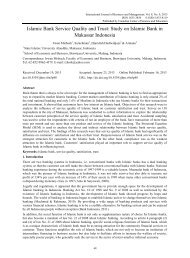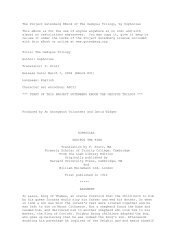The Oil Industry in Nazi Germany, 1936-1945
The Oil Industry in Nazi Germany, 1936-1945
The Oil Industry in Nazi Germany, 1936-1945
Create successful ePaper yourself
Turn your PDF publications into a flip-book with our unique Google optimized e-Paper software.
NAZI OIL INDUSTRY 265<br />
War II, it is still significant that a version of the process that was ne-<br />
glected under the <strong>Nazi</strong> regime is today used commercially to a much<br />
greater degree than the process the <strong>Nazi</strong>s favored.32 <strong>The</strong> explanation<br />
of the regime's preference lies primarily <strong>in</strong> three other factors: differ-<br />
ences <strong>in</strong> the raw materials used <strong>in</strong> each process; differences <strong>in</strong> the f<strong>in</strong>al<br />
products and <strong>in</strong> the usefulness of each process given the technology of<br />
the day; and crucial differences <strong>in</strong> political power. <strong>The</strong> key figures <strong>in</strong><br />
the two firms <strong>in</strong>volved <strong>in</strong> synthetic production held very different<br />
places <strong>in</strong> the <strong>Nazi</strong> regime.<br />
<strong>The</strong> two major synthetic fuel processes used <strong>in</strong> <strong>Nazi</strong> <strong>Germany</strong>-the<br />
Fischer-Tropsch process and the Bergius hydrogenation process-<br />
were similar <strong>in</strong> some respects. Both were pioneered <strong>in</strong> <strong>Germany</strong> by<br />
German scientists. <strong>The</strong> patent rights to both were owned by German<br />
companies, and both used the same basic raw materials: coal, water,<br />
and air.<br />
<strong>The</strong> processes differed considerably <strong>in</strong> other ways, however. <strong>The</strong><br />
Fischer-Tropsch process was first developed around 1930 by Franz<br />
Fischer and other scientists work<strong>in</strong>g at the Kaiser Wilhelm Institute<br />
for Coal Research at Miilheim. <strong>The</strong> process <strong>in</strong>volved the comb<strong>in</strong>ation<br />
of carbon dioxide and hydrogen, derived from coal and steam, by<br />
means of a catalyst at fairly low temperatures (around 2000 C) and pres-<br />
sures (up to 20 atmospheres). Coke, which was <strong>in</strong> oversupply <strong>in</strong> Ger-<br />
many when the process was developed, was the preferred raw material<br />
for Fischer-Tropsch synthesis, although both hard coal and lignite were<br />
also used. Among the f<strong>in</strong>al products of the process was a low-grade<br />
crude oil, which, while it could not be used to produce aviation fuel,<br />
was further ref<strong>in</strong>ed to produce gasol<strong>in</strong>e, diesel fuel, and waxes. <strong>The</strong><br />
process could also be used to produce several nonfuel chemicals, such<br />
as alcohols and res<strong>in</strong>s. <strong>The</strong> rights to the process were purchased by<br />
Ruhrchemie, a German chemical concern, which built the first com-<br />
mercial Fischer-Tropsch plant on the grounds of its synthetic ammonia<br />
plant at Holten <strong>in</strong> 1934.33<br />
In contrast to the Fischer-Tropsch process, the Bergius hydrogena-<br />
tion process was performed at high temperatures (400-600' C) and<br />
pressures (200-700 atmospheres). Although this process could employ<br />
any carbonaceous material, brown coal, abundant <strong>in</strong> <strong>Germany</strong>, was<br />
most often used. <strong>The</strong> coal, or other carbon-based material, was com-<br />
b<strong>in</strong>ed with hydrogen <strong>in</strong> the presence of a catalyst to form synthetic<br />
petroleum products. Bergius hydrogenation further differed from the<br />
Fischer-Tropsch process <strong>in</strong> that the f<strong>in</strong>al product was high-grade gas-<br />
32 A modified version of the Fischer-Tropsch process is used <strong>in</strong> the synthetic oil plants of South Africa,<br />
the country with the largest synthetic fuel production <strong>in</strong> the world today.<br />
33 USSBS 113, German <strong>Oil</strong> <strong>Industry</strong>, sec. 1.03, 10-11.












